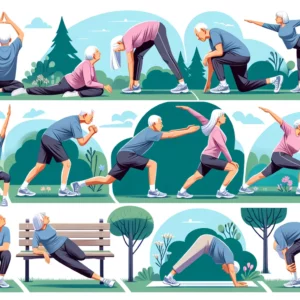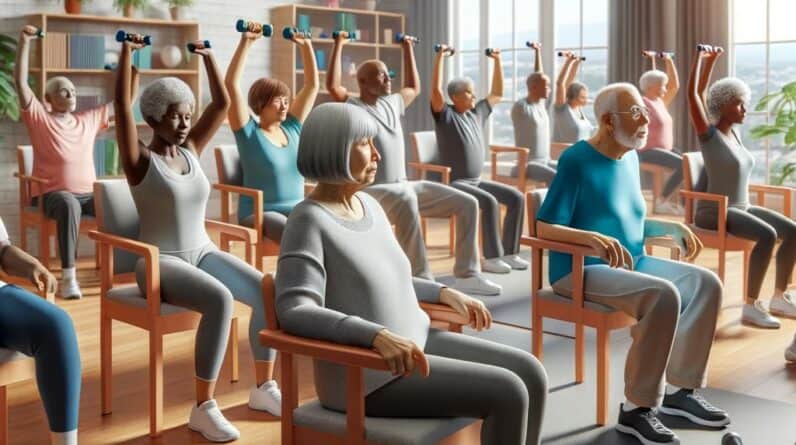Introduction to the Importance of Stretching Exercises for Flexibility and Mobility
As we grow older, the importance of stretching exercises for flexibility and mobility becomes a key aspect of our health and wellness journey.

Dementia Discovery That is Leaving Doctors Speechless (Try This Tonight)
Better than Morphine For Joint Pain… Yet Safer Than Aspirin?
Retire With Freedom. Start Earning Extra Cash Today.
These elements are essential not just for everyday activities like bending to tie shoes or reaching for items on a high shelf, but also for reducing the risk of injuries, improving posture, and enhancing our overall quality of life.
Flexibility refers to the ability of our muscles to stretch, while mobility is about how freely our joints can move. Together, they form the foundation of our physical freedom, especially as we enter our 50s and beyond.
Understanding the value of flexibility and mobility is the first step towards a healthier, more active lifestyle. In this age bracket, our bodies start to naturally lose some of their elasticity and range of motion, making it all the more crucial to focus on these areas.
By integrating regular stretching exercises into our daily routine, we can combat the effects of aging, improve our functional movements, and enjoy a more active and pain-free life.
This guide aims to provide you with practical and effective ways to enhance your flexibility and mobility, regardless of your current fitness level.
Understanding the Basics of Stretching
Stretching is a fundamental component of any fitness routine, yet it’s often overlooked or misunderstood.
There are several types of stretching, each with its unique benefits and applications. Static stretching, for instance, involves holding a stretch for some time in a stationary position. It’s excellent for cooling down after exercise and increasing overall flexibility.
Dynamic stretching, on the other hand, involves moving parts of your body and gradually increasing the reach or speed of movement. It’s ideal as a warm-up to prepare the muscles for activity.
Other forms of stretching include ballistic stretching, which uses the momentum of a moving body or limb to push it beyond its normal range of motion, and PNF (Proprioceptive Neuromuscular Facilitation) stretching, a more advanced technique that combines stretching and contracting the muscle group being targeted.
While ballistic stretching can be effective, it’s generally not recommended for beginners or those over 50 due to the higher risk of injury.
PNF stretching, however, can be particularly beneficial for improving both flexibility and strength, but it should be performed under the guidance of a professional.
Understanding these different types will help you choose the right stretching exercises to include in your routine, based on your fitness goals and current level of flexibility.
Hip Flexor
For individuals over 50, certain stretching exercises can be particularly beneficial for improving flexibility. Hamstring stretches, for example, are crucial. Many adults suffer from tight hamstrings, which can lead to lower back pain and reduced mobility.
To perform a hamstring stretch, sit on the ground with one leg extended and the other bent, and gently lean forward from the hips towards your extended foot.
Hold the stretch for about 30 seconds, then switch legs. This stretch can be done daily and is effective in increasing leg flexibility and reducing back discomfort.
Another important area to focus on is the hips, often neglected yet vital for mobility. Lunges and hip flexor stretches are excellent for this.
Lunges not only stretch the hip flexors but also strengthen the lower body. To perform a lunge, step forward with one foot and lower your hips until both knees are bent at about a 90-degree angle.
Ensure your front knee is directly above your ankle and your other knee doesn’t touch the floor. Hold this position for 30 seconds and then switch legs. For the upper body, chest and shoulder stretches are essential.
Tight chest muscles can lead to poor posture and upper back pain. A simple stretch is to clasp your hands behind your back, straighten your arms and gently lift your hands upwards.
Hold this for 20-30 seconds. Regularly performing these stretches can significantly improve your range of motion and reduce the risk of pain and injury.
Mobility-Enhancing Stretching Routines
Mobility stretches are key to maintaining joint health and preventing stiffness. For ankle and wrist mobility, simple rotational exercises can be highly effective.
Rotate your wrists and ankles in a circular motion, first in one direction, then the other, for about 30 seconds each. This can help reduce joint pain and improve the range of motion, which is particularly important for everyday tasks like walking or typing.
For spinal health, incorporating stretches and rotations into your routine is vital. The spine is central to our body’s mobility, and keeping it flexible is essential for preventing pain and stiffness.
A gentle stretch is the seated spinal twist: Sit on the floor with your legs extended, bend one knee over the other leg, and twist your torso towards the bent knee, using your arm for support. Hold for 30 seconds, then switch sides.
This stretch not only improves spinal mobility but also aids in digestion and stimulates the internal organs. Incorporating these mobility exercises into your daily routine can greatly enhance your functional movements and overall athletic performance, leading to a more active and fulfilling lifestyle.
Creating a Personalized Stretching Program

When it comes to stretching, one size does not fit all. It’s important to assess your current level of flexibility and mobility and tailor a program that suits your individual needs and goals. Start by identifying areas where you feel particularly tight or limited in movement.
This could be your legs, back, shoulders, or any other part of your body. Based on this assessment, select stretches that target those specific areas.
Building a sequence of stretches might seem daunting at first, but the key is to start simple. Choose a few stretches and focus on performing them correctly and consistently. As you progress, you can add more stretches or increase the intensity and duration.
Remember, improvement in flexibility and mobility is a gradual process, and patience is crucial. Regular practice will yield better results, and over time, you’ll likely find that you’re able to perform stretches with greater ease and less discomfort.
Additionally, as your body changes and adapts, it’s important to periodically re-evaluate your routine and make adjustments as needed to continue challenging your muscles and joints.
Safety Tips and Best Practices for Stretching
When embarking on a stretching routine, especially for those over 50, safety should always be a top priority. A common mistake is stretching cold muscles, which can lead to injuries.
Always start with a light warm-up, like walking or gentle jogging, to get the blood flowing to your muscles. This prepares them for the stretching exercises and makes them more pliable.
Another key point is understanding the difference between warm-up and cool-down stretches. Warm-up stretches, typically dynamic, prepare your body for physical activity, while cool-down stretches, usually static, help to relax your muscles after a workout and improve flexibility over time.
Stretching should never be painful; feeling a gentle pull in the muscles is normal, but if you experience pain, stop immediately. It’s also important to breathe normally while stretching; holding your breath can increase tension in your muscles.
In terms of frequency, incorporating stretching into your daily routine is ideal. However, if that’s not possible, aim for at least 3-4 times a week to see improvements in flexibility and mobility.
Lastly, if you have any pre-existing conditions or injuries, it’s advisable to consult with a healthcare professional or a physical therapist before starting a new stretching regimen. They can provide guidance and help you avoid common mistakes, ensuring that your stretching routine is both safe and effective.
Disclaimer: The information in this article is intended for educational and entertainment purposes only and should not be used instead of or contrary to that of a medical professional.
Before taking supplements, starting a new diet, or embarking on a new exercise regime please consult a medical or nutritional professional.
The owners of “Getting Healthy After 50” are not medical professionals and are simply redistributing information that is freely available on the internet.







